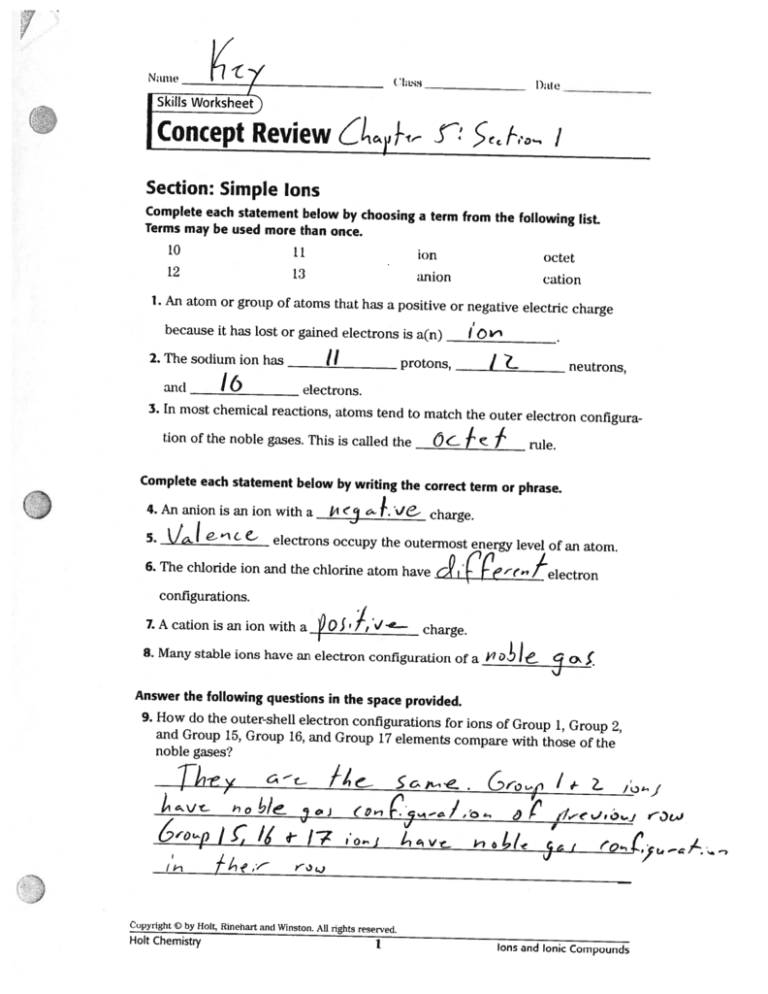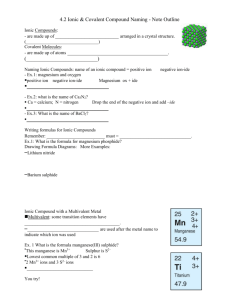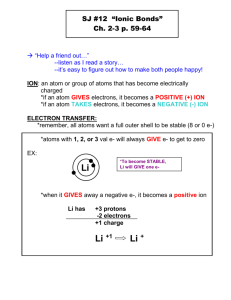
_______
_____
_____
_____
____
(I;iss
I)aI
Skills Worksheet
1
p
t Review
LF-
Sf
S
I
Section: Simple Ions
Complete each statement
Terms may
be used
more
below by choosing
than once.
a term from
the following list.
10
II
ion
octet
12
13
anion
cation
1. An atom or group of atoms that has a positive or negative
electric charge
because it has lost or gained electrons is a(n)
IOV
II
2. The sodium ion has
16
and
/ l_.
protons,
neutrons,
electrons.
3. In most chemical reactions, atoms tend to match
the outer electron configura
tion of the noble gases. This is called the
Complete each
statement
below by writing the
4. An anion is an ion with a
I
Oc
I
Lute.
correct term or
1
phrase.
charge.
electrons occupy the outeost energy level of an atom.
6. The chloride ion and the chlorine atom have
‘electron
configurations.
7. A cation is an ion with a
1
)OJ
’f
charge.
B. Many stable ions have an electron configuration of a
°‘
Answer the following questio
ns in the space provided.
9. How do the outer-shell electron configurations for
ions of Group 1, Group 2,
and Group 15, Group 16, and Group 17 elements compare
with those of the
noble gases?
fo(
11
‘
o
V
I
/6’
oJ
17
(O
‘oj
--
/
/
.
Er
4/
I
(
Copyright © by Hoft, Rinehart and Winston. All rights reserve
d.
Hoft Chemistry
1
Ions and Ionic Compounds
I )a(’
lass
I
Nain
I Concept Review continued
10. What (to Y’OU
(iroiup 15?
110(1CC LhotIL aLl ol I
Group
lie
ionic charges
for Umup 1? ( roup 2?
16? Group [7?
6 I
-
1 1. [low uiiany Valallce electrons
16, and Group 17 have?
(to atoruus in
/, 6-
6,
i-
Group 1, Group 2, Group 15, Group
z.
2
r
/
/
16
7
12. State the octet rule.
T
Ar
y
/
j
i
O
O
/o5
2
e(J-c /
le’7(
13. Ions of calcium, fluorine, magnesium, and iodine have electron configurations
that are similar to which noble
gases?
3
p
Xe
de,,from those of their parent atoms.
14. Explain why the properties of io
Po
(
hv
S
15. Why (to atoms of metals form cations?
4
L/
16. Why do atoms of nonmetals form anions?
I
‘;
y•
C
F
:
J
)
Copyright © by unit, Rinehart and Winston. All tights reserved.
Holt Chemistry
2
Ions and Ionic Compounds
_______
I)ae
(lass
Worksheet 4.1
-
Sections a and b: Ionic Bonding
1.
If
represents a chlorine atom, then model
best represents a
Q
chloride ion.
a.
b.
c.Q
d.Q
2. In Section a, when the sodium atom becomes a sodium ion, how does the size and
electron configuration of the sodium atom change? Explain what happens, and write
the electron con figuration for the atom and for the ion.
S J’
(
J
f
c’i1
‘
3. 2
CaF and NaCI are examples of ionic bonding. Why does CaF
2 have two anions per
cation while NaCI has a cation to anion ratio of 1 :1?
L
-
j
/, 4
(
f
ItL
3. Each ion formed in Sections a and b attains a noble gas configuration. How can you
recognize a noble gas configuration by looking at the electron configuration?
c)j
‘F
-.,
(1
I bit ChemFile interactive Futor
Copyright C by Holt. Rinehart and Winston AN rights resereed.
_________________________
______________________________________________
_________________
_______________
(hiss
I )ate
Name
Worksheet 4.1 continued
5. In
Section
a
C
an ionic
compound was formed between calcium and
Which
a.
atom,
calcium
b. Which atom will
What
c.
C
6. An
ionic compound
What
is
to
fluorine,
forms a positively
increase in size or
the charge
d. Write the
Sections a and h
a.
is
or
formula
on
fluorine.
Volume when its ion
torrned?
compound.
formed tiom strontium and chlorine. Use what
answer the following questions.
is
of
is
ion?
the anion?
for [he ionic
the electron con hguration
charged
the
you
learned
in
strontium ion’?
(]
b. I-low many chlorine atoms are needed to accept all the electrons lost by strontium?
2
c.
Using Section h as a model, diagram the formation of strontium chloride. Show the
change in size for each atom as it becomes an ion. Then show the relative numbers
of ions that combine to form one unit of the ionic crystal. Use circles to represent
each atom and ion.
Strontium ion(s)
Strontium atom(s)
Chlorine atom(s)
+
Strontium
Chloride ion(s)
chloride,
Chemical lormula
Holt ChemFile interactive Tutor
C’opvright © b Holt. Rinehart and Winston. All riuhts reserved
2
______________________________
___________
_____
( lt.s
I )ak’
Ac—
Concept’Review
[Wo
f
C/j’o
2_
Section: Ionic Bonding and Salts
Complete each
statement
below by
1. L’he arrangement of ion
6
by
writing
[H 50(1mm
the
correct
term
or
phrase.
chloride shows that each ion is surrounde(l
op)ositely-charge(I
LOflS.
2. The attractive force between sodium ions and chloride ions results in an
arrangement of ions in repeating units arranged to fo a
CY ck I
!
3. In the sodium chloride crystal arrangement, the net effect is that the
between oppositely charged ions is significantly greater
than
between ions of like charge.
4. The arrangement of cations and anions depends on the
the
and
oftheions.
Complete each
statement
lattice energy
below by choosing
salt
a
term
from
the following list.
unit cell
crystal lattice
5. The specific way in which atoms are arranged in an ionic compound is called
the (7I
6. The
!
ire
-c—
is the simplest repeating unit of a crystal structure.
7. A
is a compound that results when an ionic bond is formed
between a cation and an anion.
8. When 1 mole of a salt is formed from gaseous ions,
re Leased.
Answer the following
questions
in
the
space
/ iA
is
‘
I
provided.
9. Briefly describe why the structure of ionic compounds causes the compounds
to be hard.
SIO2c
I
(opyright © by bit, Rinehart and Winston. All rights reserved.
Holt Chemistry
3
Ions and Ionic Compounds
I
Naitie
——_________________________
Review continued
j Concept
10. When a torce is applied to an ionic compound and the ions arc repositioned
so I hat like—charged ions are located next to each oilier, what happens to the
Coflul)oLlfl([?
(
11. 1 [ow
is an ionic
bond
formed?
‘
.
foçb’
,_vv,_
‘/
12. Define S(tlt.
-,
O’
13. Why do
4
J
J
1
o-
iL
ionic compounds have
high
melting points
,J /
[r o
and high boiling
points?
L
1
14. Why
are
ionic
solids
Øar/.
15. When
are
generally poor conductors of electricity?
/e”f
salts excellent
,-f
‘1’
conductors of electricity?
/
i
/
I
(CA
Copyright © by Flolt. Rinehart and Winston. All rights reserved.
Holt Chemistry
4
Ions and Ionic Compounds
)
_____________________________
N:itm
(lass
I )atc
I Concept Review continued
16. Name live chatcteristics ol lOlliC C01U
)OtlfldS.
1
LJ
Z HJ L?-4-Fk
3 Se t.J d nJ
g. C, J
I. $
<
-‘
,
/i
i
J
-
..,4
i. 49?
*
17. Flow (10 these five properties relate to the nature of ionic bonds?
I,
.
2..
Oft’
’ç
4
/’f
?.
c.
4
f
r
?.c/)
’Ji,
/q’4../.J
,‘jio/ie,J
C
1
c/’3
.
6-i
Fefy
L’.J
£1 4
4 ‘IL-
H
1
f
/
1
,.*s.,
e
18. Describe the structure of salt crystals.
-)
,
Ai
•
Copyright © by Holt, Rinehart and Winston. All rights reserved.
Holt Chemistry
5
Tons and Ionic Compounds
___
__
___________
_____________________________________________________________
___________
I
( Ii_ss
Nanie
Skills Worksheet)
froncept Review LC- s
3
Section: Names and Formulas of Ionic Compounds
Complete each statement below by choosing a term from the following list.
Terms may be used more than once.
Roman numerals
-ide
electrorLeutrality
cations
..
J)Olyat.OflhiC
subscrIpt
iOniC
1. Flaying equal amounts of positive and negative charges is called
€
/e /,
J,
2. An electrically charged group of two or more bonded atoms that functions as
ion.
a single ion is a
Cc I’’
J
are never found without a similar number of
3. Collections of
anions (or sometimes electrons) nearby to effectively neutralize the charges.
4
names for
formed.
C
come from the element from which they are
5. When an element forms two or more positive ions, the ions are distinguished
by using
0
to indicate the charge.
6. The name of a simple anion is formed by changing the ending of the element
name
to
is a whole number written below and to the right of an
7. A
element’s symbol, and it is used to denote the number of atoms in a formula.
8. Any chemical compound that is composed of oppositely charged ions is called
compound.
a(n)
Write the formula for the following compounds.
9. potassium bromide
10. barium fluoride
11. tin(TV) oxide
r
,
,
Copyright © by Holt, Rinehart and Winston. All rights reseived.
6
Halt Chemistry
Ions and Ionic Compounds
)
___
___
__
___________
___________
Naiiu
I )ate
I Concept Review continued
12.
((‘SItilil
bromide
13. (obalt(Il) I)rotfli( Ic
L3
14. tnercury(I) sulftde
15. aluminum Lodi(Ie
3
4fL
Write the names of the following, and include Roman numerals if needed.
ci)
16.Cu
ii.c1
2
N
1
25.Mg
18. 02
LIII)
3
0
2
24.Fe
.
)
26. ZnO
1
!
.Jc.
s’i4
j
,.i
L
?
20.Na
0
2
28.Cu
fJi 2s2i
f’o’ ‘-u- i) x’S.
2
21.Mg
2
29.CaCl
(%
l9.P
øL;%
22. NaC1
23.ZnS
Answer the
27.NaI
2.
‘S’
30. CrC1
3
(Iii)
31.HgO
fll)..’’Jr.
following questions in the space provided.
32. How are polyatomic salts named?
.—g/
-i,k
,.
33. How do the formulas for atomic salts relate to their names?
11
Copyright © by Flolt, Rinehart and Winston. All rights reserved.
Holt Chemistry
7
Ions and Ionic Compounds
_______
______
I )ate
( ‘lLs.s
Nan it’
I Concept Review continued
Choose the statement from Column B that best matches the term in Column A, and
write the corresponding letter in the space provided.
)
Column B
Column A
a. indicates the presence of one hydrogen atom in
34. -ite and -ute
the ion
0
35. mnonohydrogen
b. the endings of polyatomic ions containing
oxygen
36. (lihydrogen
c. “replace an oxygen by a sulfur” in the anion
7 tkio
.
3
C
d. indicates the presence of two hydrogens in the
ion
Write the name for the following compounds that contain polyatomic ions.
Cr
K
7
O
38. 2
9
39.KC1O
)
3
40.Fe(C10
,
t
P
/L
Jb”
fDSJ.’ui
ti!) I/’/t.
3
J1
O
1
S
2
41.Na
çj..
O
3
S
9
42.Na
4
43.KMnO.
9
)
3
44.Pb(N0
/*Ø(
€ii)
Write the formula for the following compounds containing polyatomic ions.
45 lead (IV) chromate
46. sodium hypochiorite
47. magnesium nitrate
(s
/r
‘i
4/ 0
‘
48. sodium peroxide
49. hydrogen cyanide
50. aluminum hydroxide
51. ammonium sulfate
Copyright © by Holt, Rinehart and Winston. All rights reserved.
Holt Chemistry
8
Ions and Ionic Compounds
c’ipter 5 Study Guide
Name:
I’l
Completion
Complete each sentence or statement.
1. The tendency of atoms of elements ço gain or lose electrons so that their outer s and p orbitals are filled with eight
electrons is called the
rule.
(‘9 (
i
2. An electron that occupies the outermost energy level of an atom is known as a(n)
electron.
V I ‘i
3. An atom or group of atoms that has an electrical charge because it has either lost or gained one or more electrons
isa(n) Z
4. An ion that has a positive charge is a(n)
5. An ion that has a negative charge is a(n)
A
6. The ion formed by an atom of a metal is a(n)
‘Ce”
C
.
0
7. The ion formed by an atom of a nonmetal element is a(n)
8. A compound resulting from the formation of an ionic bond between a cation and an anion is a(n)
9. A repetiçive aeqmetri arrangement of ions, atoms, or molecules that forms a crystal structure is called the
i
.
10. The crystal structure of a salt depends on the
of cations to anions.
r
2.
/
11. In naming a binary ionic compound, the name of the
ii/
ofthe
0f
12. The name of the ion 02_ is the
13. The name of the ion Cu is the
(
of the cation and anion and the
‘
‘appears first followed by the name
ion.
(I)
ion.
14. The chemical formula for the compound potassium fluoride, which contains K and V ions, is
xc
15. The chemical formula for the compound strontium sulfide, which contains Sr
2 and S
2 ions, is
16. An electrically charged group of two or more bonded atoms that functions as a single ion is called a(n)
ion.
17. The chemical formula for the compound sodium chlorite, which contains Na and CIC ions, is
/y E/
18. The formula for the compound ammonium sulfate, which contains and ions, is
(WHi)
co
Short Answer
Why?
19. Will fluorine (atomic number 9) form an anion, or a cation?
4
//
,,
e ion is an anion have to do with why sodium and
20. What does the fact that a sodium ion is a cation and a chlorid
chlorine form a bond?
2(7foc/
21. Describe the nature of an ionic compound.
.”
2
22. Explain what is meant by “the lattice energy of BeF
TLt
2 is an anion and not an ionic compound?
23. How do you know that N0
1
&
.1




